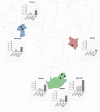Apolipoprotein L1 High-Risk Genotypes and Albuminuria in Sub-Saharan African Populations
- PMID: 35577564
- PMCID: PMC9269651
- DOI: 10.2215/CJN.14321121
Apolipoprotein L1 High-Risk Genotypes and Albuminuria in Sub-Saharan African Populations
Abstract
Background and objectives: Recessive inheritance of African-specific APOL1 kidney risk variants is associated with higher risk of nondiabetic kidney disease, progression to kidney failure, and early-onset albuminuria that precedes eGFR decline. The effect of APOL1 risk variants on kidney disease in continental Africans is understudied. Objectives of this study were to determine APOL1 risk allele prevalence and associations between APOL1 genotypes and kidney disease in West, East, and South Africa.
Design, setting, participants, & measurements: This cross-sectional population-based study in four African countries included 10,769 participants largely aged 40-60 years with sociodemographic and health information, anthropometry data, and blood and urine tests for biomarkers of kidney disease. APOL1 risk alleles were imputed from the H3Africa genotyping array, APOL1 risk allele and genotype frequencies were determined, and genetic associations were assessed for kidney disease. Kidney disease was defined as the presence of eGFR <60 ml/min per 1.73 m2, albuminuria, or a composite end point including eGFR <60 ml/min per 1.73 m2 and/or albuminuria.
Results: High G1 allele frequencies occurred in South and West Africa (approximately 7%-13%). G2 allele frequencies were highest in South Africa (15%-24%), followed by West Africa (9%-12%). Associations between APOL1 risk variants and albuminuria were significant for recessive (odds ratio, 1.63; 95% confidence interval, 1.25 to 2.12) and additive (odds ratio, 1.39; 95% confidence interval, 1.09 to 1.76) models. Associations were stronger for APOL1 G1/G1 genotypes versus G0/G0 (odds ratio, 3.87; 95% confidence interval, 2.16 to 6.93) compared with either G2/G2 (odds ratio, 1.65; 95% confidence interval, 1.09 to 2.51) or G1/G2 (odds ratio, 1.24; 95% confidence interval, 0.83 to 1.87). No association between APOL1 risk variants and eGFR <60 ml/min per 1.73 m2 was observed.
Conclusions: APOL1 G1 and G2 alleles and high-risk genotype frequencies differed between and within West and South Africa and were almost absent from East Africa. APOL1 risk variants were associated with albuminuria but not eGFR <60 ml/min per 1.73 m2. There may be differential effects of homozygous G1 and G2 genotypes on albuminuria that require further investigation.
Podcast: This article contains a podcast at https://www.asn-online.org/media/podcast/CJASN/2022_05_16_CJN14321121.mp3.
Keywords: albuminuria; apolipoprotein L1; chronic kidney disease; glomerular filtration rate; molecular genetics.
Copyright © 2022 by the American Society of Nephrology.
Figures


References
-
- Ashuntantang G, Osafo C, Olowu WA, Arogundade F, Niang A, Porter J, Naicker S, Luyckx VA: Outcomes in adults and children with end-stage kidney disease requiring dialysis in sub-Saharan Africa: A systematic review. Lancet Glob Health 5: e408–e417, 2017 - PubMed
-
- Kopp JB, Smith MW, Nelson GW, Johnson RC, Freedman BI, Bowden DW, Oleksyk T, McKenzie LM, Kajiyama H, Ahuja TS, Berns JS, Briggs W, Cho ME, Dart RA, Kimmel PL, Korbet SM, Michel DM, Mokrzycki MH, Schelling JR, Simon E, Trachtman H, Vlahov D, Winkler CA: MYH9 is a major-effect risk gene for focal segmental glomerulosclerosis. Nat Genet 40: 1175–1184, 2008 - PMC - PubMed
-
- Kao WH, Klag MJ, Meoni LA, Reich D, Berthier-Schaad Y, Li M, Coresh J, Patterson N, Tandon A, Powe NR, Fink NE, Sadler JH, Weir MR, Abboud HE, Adler SG, Divers J, Iyengar SK, Freedman BI, Kimmel PL, Knowler WC, Kohn OF, Kramp K, Leehey DJ, Nicholas SB, Pahl MV, Schelling JR, Sedor JR, Thornley-Brown D, Winkler CA, Smith MW, Parekh RS; Family Investigation of Nephropathy and Diabetes Research Group : MYH9 is associated with nondiabetic end-stage renal disease in African Americans. Nat Genet 40: 1185–1192, 2008 - PMC - PubMed
-
- Genovese G, Friedman DJ, Ross MD, Lecordier L, Uzureau P, Freedman BI, Bowden DW, Langefeld CD, Oleksyk TK, Uscinski Knob AL, Bernhardy AJ, Hicks PJ, Nelson GW, Vanhollebeke B, Winkler CA, Kopp JB, Pays E, Pollak MR: Association of trypanolytic ApoL1 variants with kidney disease in African Americans. Science 329: 841–845, 2010 - PMC - PubMed
Publication types
MeSH terms
Substances
Grants and funding
LinkOut - more resources
Full Text Sources
Research Materials
Miscellaneous

